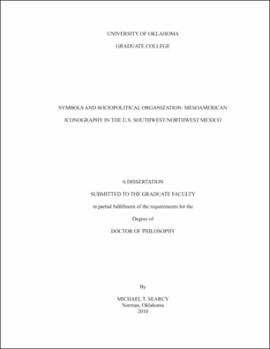| dc.contributor.advisor | Minnis, Paul E | |
| dc.creator | Searcy, Michael Taylor | |
| dc.date.accessioned | 2019-04-27T21:34:10Z | |
| dc.date.available | 2019-04-27T21:34:10Z | |
| dc.date.issued | 2010 | |
| dc.identifier | 99307494302042 | |
| dc.identifier.uri | https://hdl.handle.net/11244/319033 | |
| dc.description.abstract | Research associated with long-distance interaction often focuses on the dominating influence of large complex societies on communities in outlying regions. In contrast, this dissertation explores how intermediate societies with different types of sociopolitical organization locally integrated foreign ideas. As a case study, I examine the interaction between the U.S. Southwest/northwest Mexico (SW/NW) and Mesoamerica by conducting an iconographical analysis of Mesoamerican symbols found on pottery that was produced during the late prehistoric period (A.D. 1200-1450) in the Salado and Casas Grandes regions. | |
| dc.description.abstract | Communities in these two areas were organized in distinctly different ways. Salado sites are widespread across central/southeastern Arizona and southwestern New Mexico and in some cases were organized around dispersed regional centers. Sites in the Casas Grandes region were established around one central, primary site, Paquimé, which served as a ritual and ceremonial center of authority for surrounding communities. While the social and political structure of their societies differed, people living in both the Salado and Casas Grandes regions produced vibrant polychrome pottery using similar iconography, including symbols thought to have originated in Mesoamerica. | |
| dc.description.abstract | Helms (1993) has suggested that goods and knowledge from foreign contexts have been considered by some societies to possess special powers due to their association with distant communities. Following Helms's (1993) theoretical model and the symbolic perspectives developed by Robb (1998), I identify variation in the types and distribution of Mesoamerican symbols associated with communities of varying social hierarchy in order to determine if the integration of foreign symbols in the Salado and Casas Grandes regions were considered symbols as girders, those that worked to promote group solidarity, or symbols as tokens, those used by elites to legitimize their authority through their association with sacred foreign knowledge. | |
| dc.description.abstract | Using a revised version of Panofsky's iconographical analysis, I analyzed the decorated surfaces of 639 whole vessels, which were either Salado or Chihuahuan Polychromes with at least regional or site-level provenience. In order to determine if people in the Salado and Casas Grandes regions differentially integrated foreign Mesoamerican symbols into their existing iconographical systems, I examined the distribution of these symbols among sites organized at different levels of social hierarchy, which I labeled more or less hierarchical. | |
| dc.description.abstract | Results from the analysis indicate that elites/leaders at and around Paquimé in the Casas Grandes region used their ties to Mesoamerica as a way to legitimize their authority. By adopting and elaborating Mesoamerican symbols and accumulating exotic goods such as macaws, shell, and copper bells, these leaders signaled their connection to the foreign source of their power (symbols as tokens). In addition, local and foreign symbols were found at both more and less hierarchical sites in this region, also suggesting that these symbols were associated with a common ideology or worldview (symbols as girders). In the Salado region, however, iconography was actually found principally to have originated in the SW/NW. These symbols were also distributed equally among more and less hierarchical Salado sites, indicating that the iconography mainly represented an ideology that was a social and existential girder. | |
| dc.format.extent | 300 pages | |
| dc.format.medium | application.pdf | |
| dc.language | en_US | |
| dc.relation.requires | Adobe Acrobat Reader | |
| dc.subject | Arizona--Antiquities | |
| dc.subject | Chihuahua (Mexico : State)--Antiquities | |
| dc.subject | Salado pottery--Themes, motives | |
| dc.subject | Casas Grandes pottery--Themes, motives | |
| dc.subject | Symbolism in art--Arizona | |
| dc.subject | Symbolism in art--Mexico--Chihuahua (State) | |
| dc.subject | Salado culture | |
| dc.subject | Casas Grandes culture | |
| dc.title | Symbols and Sociopolitical Organization: Mesoamerican Iconography in the U.S. Southwest/Northwest Mexico | |
| dc.type | text | |
| dc.type | document | |
| dc.thesis.degree | Ph.D. | |
| ou.group | College of Arts and Sciences::Department of Anthropology | |
